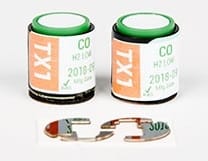Downloads
Tango TX1 Single Gas Detector
Description
The Tango TX1-G is a specialised single-gas monitor within the Tango TX1 series, designed for the continuous and reliable detection of Carbon Mnoxide (CO) with a low Hydrogen (H2) cross-sensitivity. This particular model is crucial for safeguarding workers in environments where both CO and H2 may be present, as standard CO sensors can sometimes misinterpret Hydrogen as Carbon Monoxide, leading to false alarms or inaccurate readings. The Tango TX1-G mitigates this issue through its advanced sensor technology, ensuring accurate CO detection and enhanced worker safety in industries such as steel mills, power plants, and other facilities where Hydrogen interference is a concern.
Features
- Single gas monitors for Carbon Monoxide with low Hydrogen Cross-Sensitivity
- Two button keypad
- Segment LCD shows real time value
- Three strobe-emitting visual alarm LEDs (two red; one blue)
- 100dB audible alarm at a distance of 10 cm 110dB with optional AlarmAmp
- Vibration alarm
- DualSense Technology for improved reliability.
- Guaranteed for Life with replaceable sensors and batteries that extends the life of the instrument
Tango TX1-G Sensor Specifications
| Carbon Monoxide with Low Hydrogen cross-sensitivity (CO/H2 Low) |
|
| Sensor Type: | Electrochemical |
| Measuring Range: | 0-1,000ppm |
| Resolution: | 1ppm |
| Response Time (T50): | 9 Seconds |
| (T90): | 18 Seconds |
| Operating Temp: | -20 to +50°C |
| Operating RH: | 15-95% |
| Calibration Gas: | 100ppm CO |
| Replacement Sensor: | 17155823 |
Tango TX1 Technical Specification
|
Display:
|
Segment Liquid Crystal Display (LCD)
|
||
| Alarms:
|
3 Strobe-Emitting LEDs (2 Red; 1 Blue) Vibration Alarm Audible 100dB |
||
| Operating Conditions: | -20 to +50°C, 15-95% RH (non-condensing) | ||
| Enclosure: | Polycarbonate with Rubber Overmould on top, Conductive Polycarbonate on bottom. | ||
| IP Rating: | IP66; IP67 | ||
| Battery Pack: | Replaceable 3.6V Lithium-thionyl Chloride 1.5Ah. | ||
| Dimensions: | 99 x 51 x 35mm | ||
| Weight: | 126g | ||
CO/H2 Low Sensor
The CO/H2 low sensor (not to be confused with CO/H2 Null Sensors) indicate that the sensor is designed to reduce the cross-interference of hydrogen (H2) on the CO sensor’s reading. The CO/H2 low sensor achieves this reduced cross-interference of hydrogen using two electrodes and a special catalyst with a lower sensitivity to hydrogen. It includes one sensing electrode dedicated to detecting CO and a second sensing electrode dedicated to detecting H2. A CO/H2 null sensor measures both the CO and H2 gas concentrations separately and then mathematically subtracts the H2 gas reading from the CO gas reading.
It is critical that in environments where significant levels of Hydrogen are present, you measure for CO using either a CO/H2 low or CO/H2 null sensors for example, if 100 ppm of H2 were exposed to a CO sensor that was neither a CO/H2 low nor CO/H2 null type sensor, the sensor would interpret the 100 ppm of H2 as 22 ppm of CO based on the CO sensor’s cross-sensitivity to H2. Steel mills and power plants are examples of facilities in which a CO/H2 low or CO/H2 null sensor would commonly be required.
A CO/H2 null sensor does its best to completely nullify the effect of H2 on the CO sensor. In practice, a CO/H2 null sensor will typically have 1% or less H2 cross-interference. Going back to the example, a standard CO sensor exposed to 100 ppm H2 would interpret it as 22 ppm CO. A CO/H2 low sensor exposed to 100 ppm H2 would interpret it as and display 5 ppm or less CO. The CO/H2 null sensor exposed to 100 ppm H2 would interpret it as and display 1 ppm or less CO.
Clearly, for environments with high H2 concentrations, both the CO/H2 low and CO/H2 null sensors can avoid false alarms and provide an increased level of confidence that the CO reading being displayed has not been compromised by background H2 gas levels. Using the correct sensor for your environment ensures that logged values are correct and that your staff don’t ignore alarms believing the alarm is due to an error caused by Hydrogen in the air.



